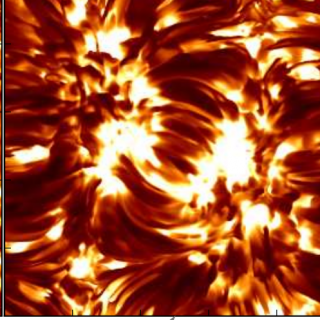Bibcode
Murabito, M.; Ermolli, I.; Giorgi, F.; Stangalini, M.; Guglielmino, S. L.; Jafarzadeh, S.; Socas-Navarro, H.; Romano, P.; Zuccarello, F.
Referencia bibliográfica
The Astrophysical Journal, Volume 873, Issue 2, article id. 126, 13 pp. (2019).
Fecha de publicación:
3
2019
Revista
Número de citas
17
Número de citas referidas
15
Descripción
We studied the physical parameters of the penumbra in a large and fully
developed sunspot, one of the largest over the last two solar cycles, by
using full-Stokes measurements taken at the photospheric Fe I 617.3 nm
and chromospheric Ca II 854.2 nm lines with the Interferometric
Bidimensional Spectrometer. Inverting measurements with the Non-LTE
inversion COde (NICOLE) code, we obtained the three-dimensional
structure of the magnetic field in the penumbra from the bottom of the
photosphere up to the middle chromosphere. We analyzed the azimuthal and
vertical gradient of the magnetic field strength and inclination. Our
results provide new insights on the properties of the penumbral magnetic
fields in the chromosphere at atmospheric heights unexplored in previous
studies. We found signatures of the small-scale spine and intraspine
structure of both the magnetic field strength and inclination at all
investigated atmospheric heights. In particular, we report typical
peak-to-peak variations of the field strength and inclination of ≈300
G and ≈20°, respectively, in the photosphere, and of ≈200 G
and ≈10° in the chromosphere. In addition, we estimated the
vertical gradient of the magnetic field strength in the studied
penumbra: we find a value of ≈0.3 G km‑1 between the
photosphere and the middle chromosphere. Interestingly, the photospheric
magnetic field gradient changes sign from negative in the inner to
positive in the outer penumbra.
Proyectos relacionados

Magnetismo, Polarización y Transferencia Radiativa en Astrofísica
Los campos magnéticos están presentes en todos los plasmas astrofísicos y controlan la mayor parte de la variabilidad que se observa en el Universo a escalas temporales intermedias. Se encuentran en estrellas, a lo largo de todo el diagrama de Hertzsprung-Russell, en galaxias, e incluso quizás en el medio intergaláctico. La polarización de la luz
Ernest
Alsina Ballester